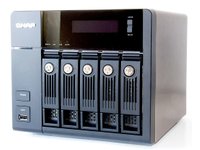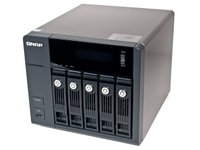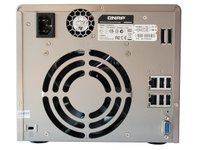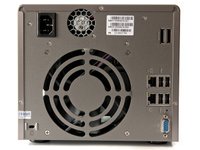Qnap TS-559 Pro+: Familiar Network Storage With A New CPU
It’s a good idea to use two CPU cores to speed up multiple drives in RAID 5 or 6 arrays and it’s even better to increase clock speeds. We put Qnap's TS-559 Pro+ with an Atom D525 dual-core CPU to the test: is it any faster than devices with Atom D510?
Hardware And Pricing Details
We only recently had an opportunity to take a closer look at the sister model of the device reviewed in this article. The Qnap TS-559 Pro (without the +) scored well thanks to its quality workmanship, efficiency, reliability, and good data transfer rates. The drawback to fairly well-polished NAS devices is usually their price. The applied to the TS-559 Pro, and it again becomes a discussion point with Qnap's TS-559 Pro+. At launch, it sold for more than $1000, and a quick look online reveals prices that still exceed that four-figure sum. And that's without hard drives, which you'll still need to buy.
Been There, Done That: The Housing
If you're prepared to shell out serious cash for the TS-559 Pro+, you of course expect something in return: mainly, good performance, an attractive housing, and capable software. If you're familiar with this unit's predecessor, the Atom D525-equipped TS-559 Pro+ won't hit you with any visual surprises. As before, Qnap's TS-559 Pro+ is housed in a rugged steel case.


Familiar Layout At The Rear Of The Housing
To be perfectly clear, the TS-559 Pro+ uses the exact same same housing as its predecessor. The dimensions are identical (185 mm height x 210 mm width x 235 mm depth). The same can be said about the connections at the rear of the device. Qnap relies on its tried-and-tested configuration of four USB 2.0 ports, two SATA 3Gb/s interfaces, and two gigabit Ethernet ports. The VGA connection familiar to users of the TS-559 Pro is also available, attributable to the Atom D510 and the Atom D525's integrated graphics unit. That's a cost-saver, since it circumvents the need for a motherboard-down graphics solution.
Ventilation of the TS-559 Pro+'s interior is achieved through a regulated 120 mm fan. A second, smaller fan transports waste heat from the integrated 220 W power supply.


Get Tom's Hardware's best news and in-depth reviews, straight to your inbox.
Current page: Hardware And Pricing Details
Prev Page Qnap TS-x59 Pro+ Series: Incremental Improvements Next Page Sticking With What Works-
hmp_goose I remember a time when teh Internet was going to have hyperlinks embedded in articles for clowns like me to look stuff up with.Reply
C'mon! I'm a knuckle-dragging FPS-player: I don't know what "SMB/CIFS protocols" stands for, let alone good for! Isn't there at lest a related article? -
barmaley Ok, I don't get it. Can someone explain to me why this $1000 device that comes with no storage is better than a $500 Linux box you can build yourself that will do everything this does and more plus it will come with tons of storage too...Reply -
sharpless78 barmaleyOk, I don't get it. Can someone explain to me why this $1000 device that comes with no storage is better than a $500 Linux box you can build yourself that will do everything this does and more plus it will come with tons of storage too...Reply
Ease of use. Very few users have the time, will and knowledge to build a NAS. -
aaron88_7 barmaleyOk, I don't get it. Can someone explain to me why this $1000 device that comes with no storage is better than a $500 Linux box you can build yourself that will do everything this does and more plus it will come with tons of storage too...First off, it isn't better than a $500 Linux box. Linux requires Linux knowledge and you have to provide the software you need yourself - that costs small businesses money. This also offers failover and load balancing with its dual NIC card that you wouldn't have in a $500 Linux box.Reply
The main thing is ease of installation. You don't need a highly technical person to get this box up and running and quickly backing up your companies data, whereas a Linux machine will require additional staff that a small business normally would not have on hand and have to pay to come onsite.
For $1000 I'd like one just to play around with myself, though it clearly is not targeted for home users. -
dealcorn I am not aware of any 5 bay hot swap itx case that could be used as a basis for a diy project with comparable functionality. Chenbro can get you to 4 at the cost of no pcie support. No pcie means no esata with a supermicro atom itx board.Reply
There are ways to go with ATX cases, but that is not really comparable. -
radiumburn but with that $500 linux box you will force yourself to learn something.. and in the end isn't it all about the pursuit of knowledge! haha well I admin a few linux servers so I'd save the cash and make my own for myself/work instead. On that note if you want I will make them for $999 and free shipping with initial phone setup!!! save a dollar!Reply -
a-nano-moose How can you compare them when you are using different hard drives than the earlier tests?Reply -
cknobman Sharpless78Ease of use. Very few users have the time, will and knowledge to build a NAS.Reply
A NAS is a computer. Heck you can even build a PC put Windows 7/XP Home edition on it and turn it into a NAS all for ~$500 (and thats even with 2tb storage in raid 1, heck that is what I have done and it works great and I am even using a low power AMD CPU that is powerful enough to actually be useful rather than a pathetic atom cpu).
There is no ease of use factor or amount of time on earth that is worth $500+ dollars.
